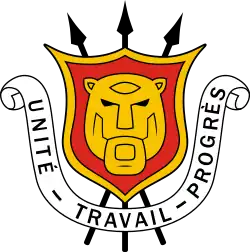 |
|---|
|
|
Indirect parliamentary elections were held in Burundi in 1954.
Background
The Decree of 14 July 1952 by the Belgian authorities had introduced an element of democracy to the Burundian political system. A complicated electoral system was created, which involved seven stages of elections to eventually elect the National Superior Council (French: Superieur du Pays).[1]
The elections began in the sub-chiefdoms, then were held in the chiefdoms, then the territories, and finally at the national level.[2]
Results
The elections in the sub-chiefdoms and chiefdoms were held in 1953, with the elections to the Territorial Councils and the Superior Council following in 1954.[3]
| Council | Members | ||||
|---|---|---|---|---|---|
| Hutus | Tutsis | Total | |||
| Elected | Unelected | Elected | Unelected | ||
| Sub-chiefdom councils | 2,285 | 0 | 1,005 | 499 | 3,789 |
| Chiefdom councils | 71 | 0 | 177 | 24 | 272 |
| Territorial councils | 16 | 0 | 52 | 24 | 92 |
| Superior Council | 0 | 4 | 27 | 31 | |
| Source: Sternberger et al. | |||||
References
- ↑ Dolf Sternberger, Bernhard Vogel, Dieter Nohlen & Klaus Landfried (1978) Die Wahl der Parlamente: Band II: Afrika, Erster Halbband, p572
- ↑ Sternberger et al, p599
- ↑ Sternberger et al, p600
This article is issued from Wikipedia. The text is licensed under Creative Commons - Attribution - Sharealike. Additional terms may apply for the media files.